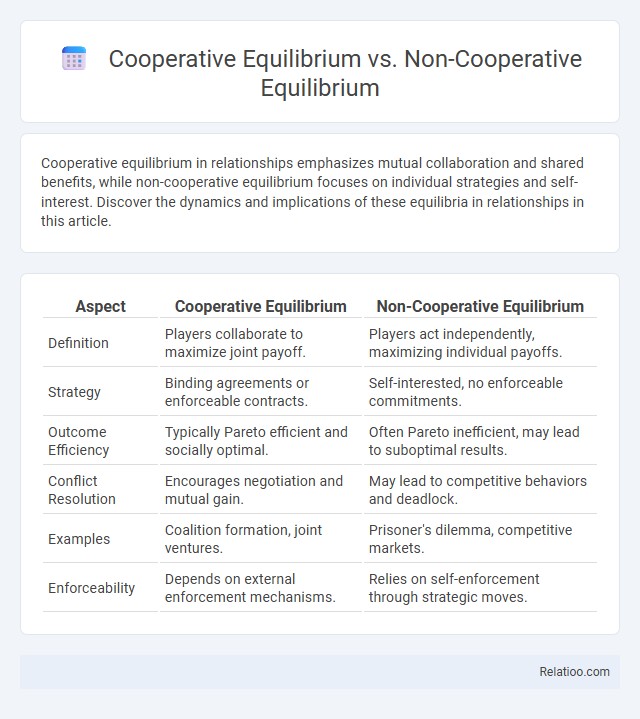Cooperative equilibrium in relationships emphasizes mutual collaboration and shared benefits, while non-cooperative equilibrium focuses on individual strategies and self-interest. Discover the dynamics and implications of these equilibria in relationships in this article.
Table of Comparison
| Aspect | Cooperative Equilibrium | Non-Cooperative Equilibrium |
|---|---|---|
| Definition | Players collaborate to maximize joint payoff. | Players act independently, maximizing individual payoffs. |
| Strategy | Binding agreements or enforceable contracts. | Self-interested, no enforceable commitments. |
| Outcome Efficiency | Typically Pareto efficient and socially optimal. | Often Pareto inefficient, may lead to suboptimal results. |
| Conflict Resolution | Encourages negotiation and mutual gain. | May lead to competitive behaviors and deadlock. |
| Examples | Coalition formation, joint ventures. | Prisoner's dilemma, competitive markets. |
| Enforceability | Depends on external enforcement mechanisms. | Relies on self-enforcement through strategic moves. |
Introduction to Cooperative and Non-Cooperative Equilibrium
Cooperative equilibrium occurs when players form binding agreements to maximize their joint payoff, making collaborative strategies essential in game theory. Non-cooperative equilibrium, such as Nash equilibrium, arises when players independently optimize their strategies without enforceable agreements, focusing on individual rationality. Understanding these concepts helps you analyze strategic interactions and predict outcomes based on whether cooperation is feasible or each player acts solely on self-interest.
Defining Cooperative Equilibrium in Game Theory
Cooperative equilibrium in game theory occurs when players form binding agreements and coordinate their strategies to achieve mutually beneficial outcomes, maximizing collective payoffs. In contrast, non-cooperative equilibrium, such as Nash equilibrium, involves players acting independently without enforceable agreements, each optimizing individual payoffs given others' strategies. Equilibrium broadly represents a stable state where no player can improve their payoff by unilaterally changing their strategy, with cooperative equilibrium emphasizing collaboration and enforceable contracts among participants.
Exploring Non-Cooperative Equilibrium Concepts
Non-Cooperative Equilibrium, particularly Nash Equilibrium, represents a state where players independently select strategies to maximize their own payoffs without binding agreements, reflecting rational decision-making in competitive environments. Unlike Cooperative Equilibrium, which involves enforceable contracts and collective strategy optimization, Non-Cooperative Equilibrium models scenarios where collaboration is not possible or credible. Understanding these equilibrium concepts is crucial for analyzing strategic interactions in economics, political science, and evolutionary biology.
Key Differences Between Cooperative and Non-Cooperative Equilibrium
Cooperative Equilibrium occurs when players in a game form binding agreements to maximize joint payoffs, while Non-Cooperative Equilibrium arises from individual strategy optimization without enforceable collaboration. Key differences include the presence of enforceable contracts in cooperative settings versus independent decision-making in non-cooperative games, affecting outcome predictability and strategy complexity. Cooperative Equilibrium often leads to Pareto improvements, whereas Non-Cooperative Equilibrium may result in Nash Equilibrium with potentially suboptimal group outcomes.
Examples of Cooperative Equilibrium in Practice
Cooperative equilibrium occurs when players in a game form binding agreements to maximize collective payoff, as seen in cartels where firms agree on prices to increase joint profits. In contrast, non-cooperative equilibrium involves players acting independently without enforceable agreements, exemplified by the Nash equilibrium in competitive markets where each firm's strategy depends on others' actions. Practical examples of cooperative equilibrium include international climate agreements, where countries commit to emission reductions for mutual benefit, and labor unions negotiating wages collectively with employers.
Real-World Cases of Non-Cooperative Equilibrium
Non-Cooperative Equilibrium occurs when individuals or firms act independently, pursuing their own strategies without collaboration, often leading to suboptimal outcomes such as in oligopolistic markets where companies compete on prices or output. Real-world cases include pricing wars between airlines or tech companies, where despite the potential gains from cooperation, competition prevails due to trust issues or regulatory constraints. Your understanding of these dynamics can reveal why businesses sometimes fail to achieve collective benefits despite clear mutual incentives in Non-Cooperative Equilibrium scenarios.
Analytical Tools for Assessing Equilibrium Types
Cooperative equilibrium, non-cooperative equilibrium, and general equilibrium each require distinct analytical tools to assess their stability and outcomes in game theory and economics. Cooperative equilibrium analysis often employs coalition formation frameworks, bargaining sets, and the core to evaluate mutual agreements among players, while non-cooperative equilibrium relies on Nash equilibrium concepts using best response dynamics and fixed-point theorems to predict individual strategic behavior. Understanding these tools allows you to accurately model and compare the effectiveness of collaborative versus independent strategic interactions within economic or strategic environments.
Impact on Strategy and Player Outcomes
Cooperative equilibrium involves players forming binding agreements, leading to strategies that maximize joint payoffs and improve Your collective outcomes through collaboration. Non-cooperative equilibrium, such as Nash equilibrium, sees players independently optimizing their strategies without enforceable agreements, often resulting in suboptimal payoffs for all involved. Equilibrium concepts highlight the strategic impact on player behavior, with cooperative settings fostering mutual benefit while non-cooperative scenarios emphasize individual rationality and potential conflicts.
Advantages and Limitations of Each Equilibrium
Cooperative equilibrium allows players to achieve mutually beneficial outcomes by coordinating strategies, resulting in higher overall payoffs but requires binding agreements and trust, which can be challenging to enforce. Non-cooperative equilibrium, such as Nash equilibrium, models strategic decision-making without cooperation, ensuring stability where no player benefits from unilaterally changing strategy, yet it may lead to suboptimal outcomes known as the "prisoner's dilemma." General equilibrium captures the interaction of multiple markets simultaneously, providing a comprehensive framework for economic equilibrium, but it relies on strong assumptions like perfect competition and complete information, limiting its real-world applicability.
Future Trends in Equilibrium Research and Applications
Future trends in equilibrium research emphasize integrating cooperative and non-cooperative equilibrium models to better predict complex economic and strategic interactions. Advances in computational techniques and machine learning enhance the ability to analyze dynamic equilibria in multi-agent systems, improving your decision-making in uncertain environments. Emerging applications in decentralized finance, autonomous systems, and network theory drive innovations that bridge theoretical equilibrium concepts with practical real-world solutions.

Infographic: Cooperative Equilibrium vs Non-Cooperative Equilibrium
 relatioo.com
relatioo.com